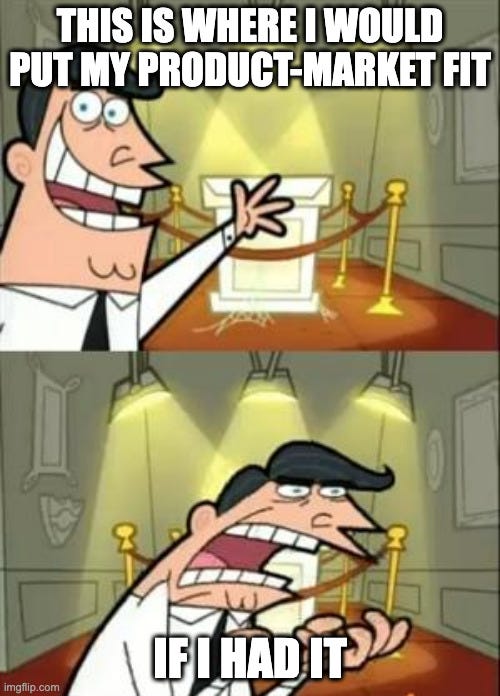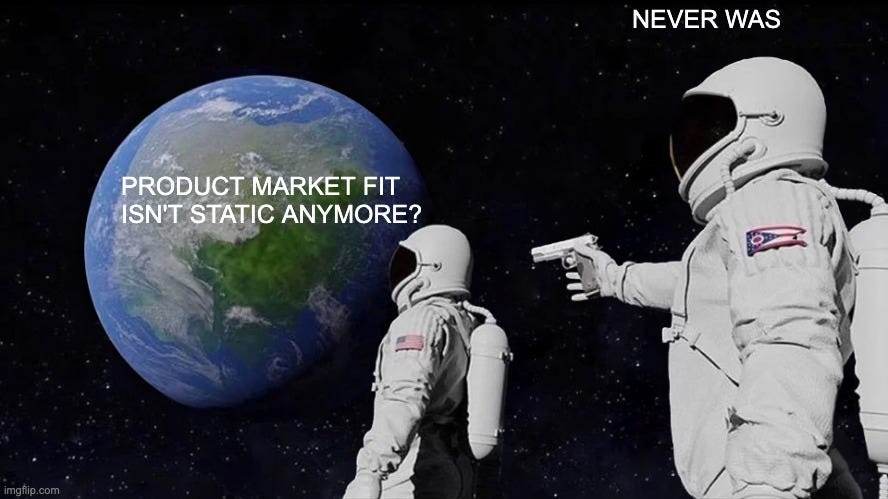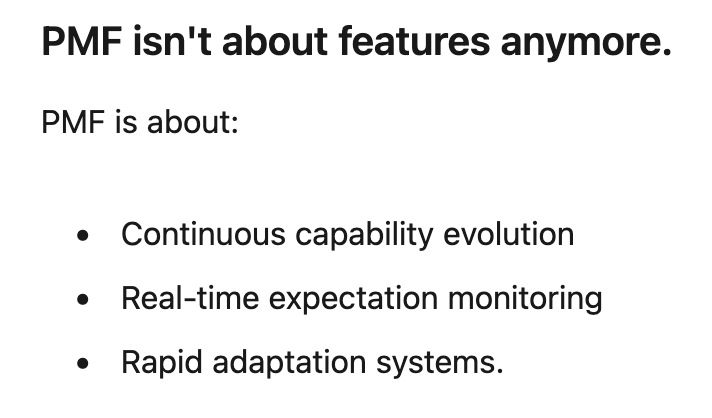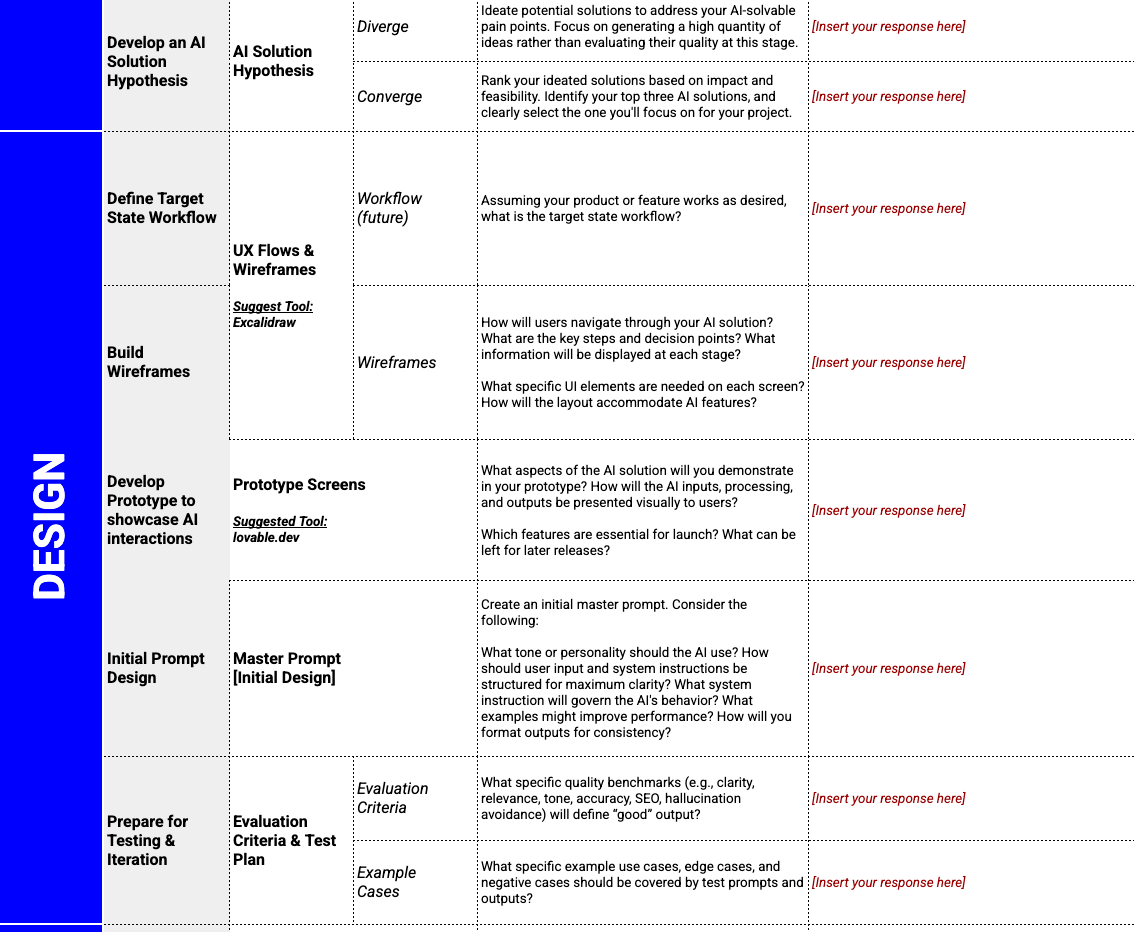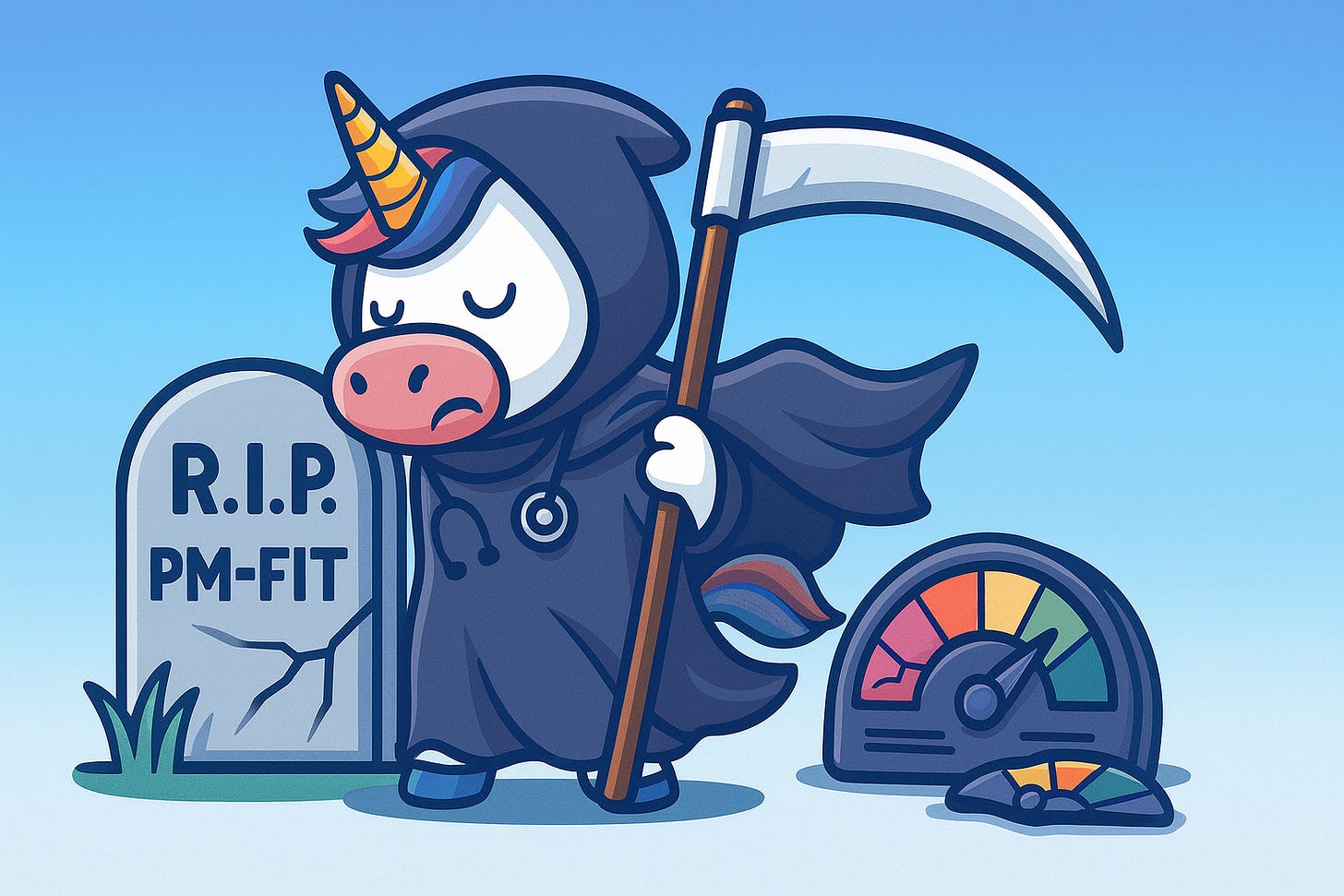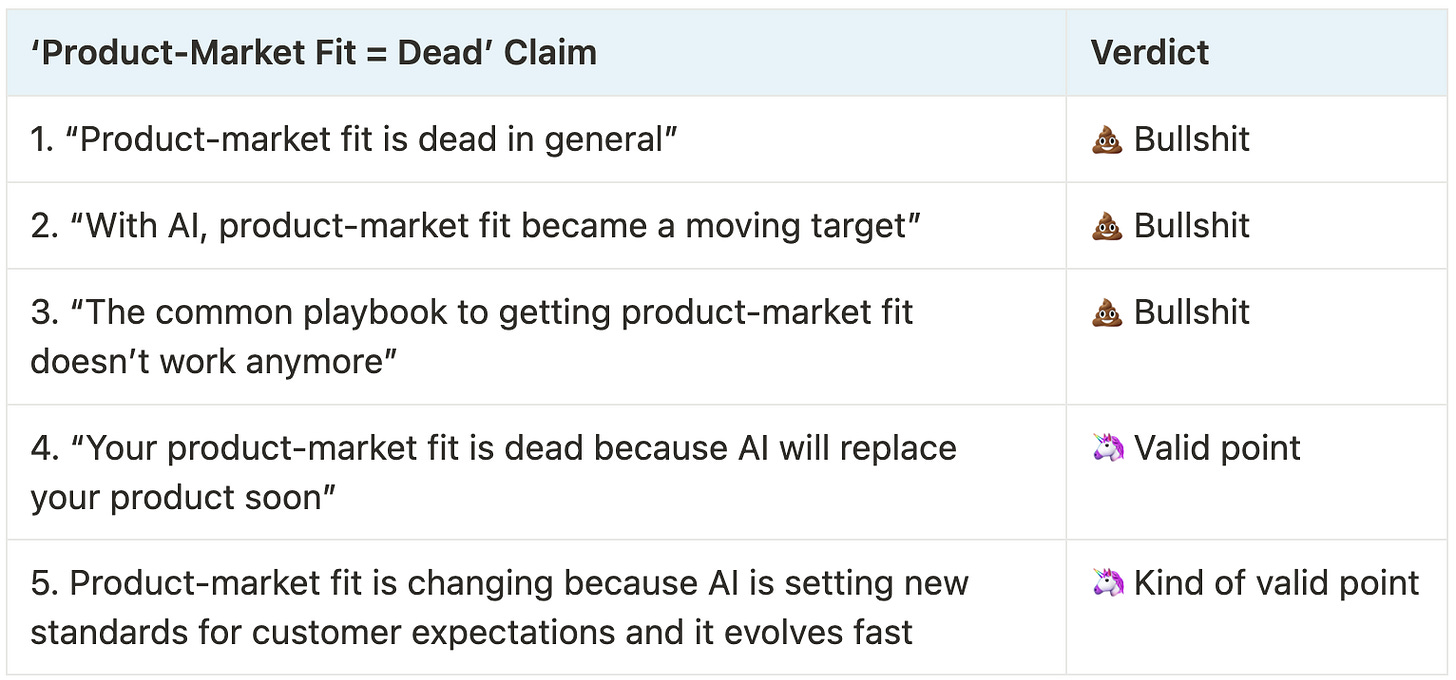No, AI didn't kill product-market fit
Detecting bullshit on five claims about AI and PM-fit
Perhaps you have seen some articles and posts claiming product-market fit is dead or broken? Four examples:


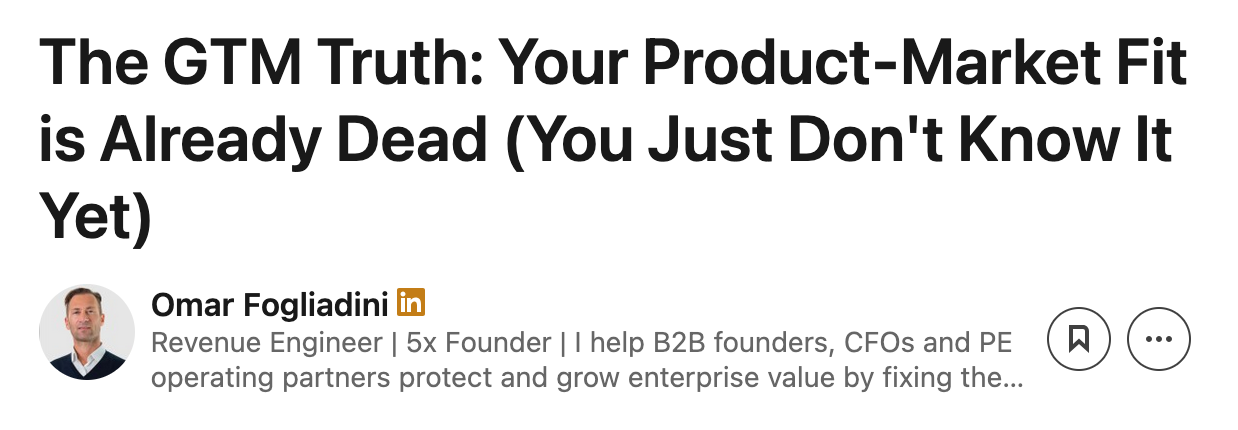

Five claims on AI and product-market fit
AI is killing a lot of things, but what precisely? It’s a mixed bag of what the above people are saying. I went through these posts, so you don’t have to.
I see five takes on the consequences of the rise of AI on PM-fit:
Product-market fit, in general, is dead
Product-market fit isn’t static anymore
The common playbook for getting product-market fit doesn’t work anymore
Your product-market fit is dead because AI will replace your product soon
Product-market fit is changing because AI is setting new standards for customer expectations
1. It’s dead in general
Claim
“Product-market fit is dead” (see screenshots above)
My thoughts
Okay, so, product-market fit as the whole idea. Which doesn’t make sense.
First, it’s a common misconception that product-market fit is some kind of Boolean switch that you toggle once you find it. I’ve stressed this before in an interview.
Product-market fit is a spectrum. It’s a sense of how well a product fits to a market. Some startups have low PM-fit, others have high PM-fit.

AI products still need to fit to a particular market. Nothing changes here.
Saying the concept pm-fit is dead due to AI is like saying the idea of temperature is dead because of the introduction of electrical thermometers. Or that with your new fancy thermometer, you can control the weather.
It’s detached: it hints at a poor understanding of what product-market fit is to begin with.
Learn what PM-fit means in this article, and some extra frameworks here.
Verdict
Claim: “Product-market fit is dead in general”
Verdict: Bullshit ❌💩
Argument: Product-market fit is a technology agnostic term. It doesn’t matter if you sell forks, cars, SaaS, or AI: your product needs to fit a particular market segment.
2. PM-Fit isn’t static anymore
Claim
“Product-Market Fit isn't static anymore. It collapses faster than you can measure it.” - Source
“In AI, PMF is a moving target. Your users’ definition of 'smart enough' evolves every month.” - Source
My thoughts
So, if it’s not dead, did it perhaps change to dynamic? Well, it was never static to begin with.
The idea that product-market fit is static only in the age of AI is bullshit. Just look at how many companies have lost product-market fit: Kodak, BlackBerry, Yahoo, Flickr, Nokia, MySpace, Nokia, Netscape, the list is endless.
Why is it not static? Because a market basically is a group of people with a similar problem, willing to spend money on it.
The nature of the problem can change, and with that, markets can shift. Therefore, as markets are dynamic, product-market fit is a moving target.
Verdict
Claim: “With AI, product-market fit became a moving target”
Verdict: Bullshit ❌💩
Thesis: PMFit always was a moving target. LLMs just have fast distribution and short time to adopt, therefore the changes seem faster than with other tech.
3. Common approach doesn’t work anymore
Claim
“The old playbook is dead” - (Src)
“PMFit is dead. At least the one you’ve been taught. OpenAI just dropped the new playbook that AI startups actually need in 2025” (src)
My thoughts
The third myth is that the common playbook is dead. What was that playbook?
So, now people propose new playbooks. These should be very different, right? Right? Here are two new playbooks.
‘New’ playbook 1
But this isn’t fully new:
Most products that have product-market fit are continuously growing and evolving. Look at Miro, Figma, Uber, to name a few. All pre-AI. Nothing new.
Most PM-Fit products got there because they monitored customers very well and understood the underlying JTBDs. Again, nothing new. The only slight change is that with prompts, you get a little extra insight into what people are trying to do, because the interface is chat-based. That gives AI a slight edge in a fundamentally similar process of getting customer feedback.
Here, people believe that agents will orchestrate their own opportunities for PM-Fit, without any implementation. Having mentored some agent-based AI startups, that is far from the current situation. It’s a hassle setting it up and getting people to use it. Hard sales for B2B startups.
‘New’ playbook 2 (4D method)
I’ve also seen the 4D method proposed as a solution. Discover, Design, Develop, Deploy. To me, this seems like pretty common steps in product development frameworks.
The 4D method is then transformed into this huge spreadsheet, without any very new things when it comes to pm-fit. Why? Because it just unpacks how the solution is different. All market segment stuff is similar to any BMC or other approach.
Basically, these folks are saying PM-fit is changing because the way products are built changes.
But then, every new technology would change the idea of PM-fit. Did social media do that? Well, the business models were relatively new, with the data harvesting etc.
But did that change the idea that the product still needs to meet user demands? Not really. Only a shift in wants was generated by the emergence of new solutions.
Claim: “The common playbook to getting product-market fit doesn’t work anymore”
Verdict: Bullshit ❌💩
Thesis: The playbook to get product-market fit hardly changed. The playbook for designing great products did, because buidling AI is a little different from SaaS. But nothing changed about the product-market stuff.
4. Product-market fit collapses can happen to anyone
Claim
“We're now witnessing something unprecedented: established products with seemingly strong product market fit experiencing sudden collapses in their core growth models” - Src
My thoughts
It suggests that some companies that were traditionally seen as having a great moat are compromised. Examples include:
Stackoverflow for dev feedback → Cursor, Lovable
Chegg.com for study notes → ChatGPT summaries
Getty images for stock photos → MidJourney or Dall-e.
Google Search → Any LLM
This is a valid point. Indeed, demonstrably, these services are declining. And what should you do instead?
Understand how your customer expectations are changing.
Evaluating your level of risk for PMF collapse.
Allocating your product portfolio of bets accordingly.
These things aren’t unique to AI, but are always valid moves to pull as a founder.
Verdict
Claim: “Your product-market fit is dead because AI will replace your product soon”
Verdict: Valid point ✨🦄
Thesis: As capitalist markets do, new innovations can kill old markets. Creative destruction is a term describing this, coined in the 1942, by Austrian economist Schumpeter, and we are seeing that for some markets now.
Need help with your product-market fit? Schedule a free intake call!
5. Product-market fit changes due to fast growing expectations from customers
Claim
“User needs evolve weekly.” - (Src)
“User expectations have exploded (thanks, ChatGPT)’ - (Src)
My thoughts
I’ve got two perspectives on changing user needs.
First, the fundamental AI shift: more and more people are talking to LLMs and finding it useful. We’re developing new expectations for how machines handle text and data—and the bar has definitely been raised.
AI also seems to be evolving faster than most technologies I’ve seen. That said, GPT-5 left many people underwhelmed. Progress here isn’t linear, and I’m the last person to predict where it’s headed. Compared to five years ago, expectations have changed dramatically. Compared to one year ago, only slightly. Over the next five? No idea.
Still, many organisations are pushing AI wherever they can. How many tools now have a chatbot? That’s partly because so much software is text-based, making it relatively easy to bolt on an LLM via an API.
But product–market fit still applies. Customer expectations may be rising, but simply adding an OpenAI API call won’t magically improve your PM-fit. It’s no silver bullet—you still have to deeply understand your customers’ needs and problems.
Verdict
Claim: “Product-market fit is changing because AI is setting new standards for customer expectations and it evolves fast”
Verdict: Kind of valid point ✨🦄
Thesis: AI did really shuffle the cards, and people are expecting more things than before. Still, many organisations struggle with implementing AI, a new chatbot doesn’t cut it.
Summary
So, no, product-market fit isn’t dead, but it did change somethings founders should keep watch of.
🔥 Jeroen’s Hot Take 🔥
A little extra for patrons. What should your startup do?
Keep reading with a 7-day free trial
Subscribe to Doctor Market Fit to keep reading this post and get 7 days of free access to the full post archives.


